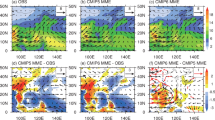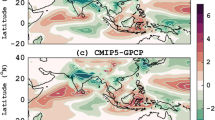Abstract
Experimental outputs of 11 Atmospheric Model Intercomparison Project (AMIP) models from phase 5 of the Coupled Model Intercomparison Project (CMIP5) are analyzed to assess the atmospheric circulation anomaly over Northern Hemisphere induced by the anomalous rainfall over tropical Pacific and Indian Ocean during boreal winter. The analysis shows that the main features of the interannual variation of tropical rainfall anomalies, especially over the Central Pacific (CP) (5°S-5°N, 175°E-135°W) and Indo-western Pacific (IWP) (20°S-20°N, 110°–150°E) are well captured in all the CMIP5/AMIP models. For the IWP and western Indian Ocean (WIO) (10°S-10°N, 45°–75°E), the anomalous rainfall is weaker in the 11 CMIP5/AMIP models than in the observation. During El Niño/La Niña mature phases in boreal winter, consistent with observations, there are geopotential height anomalies known as the Pacific North American (PNA) pattern and Indo-western Pacific and East Asia (IWPEA) pattern in the upper troposphere, and the northwestern Pacific anticyclone (cyclone) (NWPA) in the lower troposphere in the models. Comparison between the models and observations shows that the ability to simulate the PNA and NWPA pattern depends on the ability to simulate the anomalous rainfall over the CP, while the ability to simulate the IWPEA pattern is related to the ability to simulate the rainfall anomaly in the IWP and WIO, as the SST anomaly is same in AMIP experiments. It is found that the tropical rainfall anomaly is important in modeling the impact of the tropical Indo-Pacific Ocean on the extratropical atmospheric circulation anomaly.
Similar content being viewed by others
References
Alexander, M. A., I. Blade, M. Newman, J. R. Lanzante, N. C. Lau, and J. D. Scott, 2002: The atmospheric bridge: The influence of ENSO teleconnections on air-sea interaction over the global oceans. J. Climate, 15, 2205–2231.
Anderson, J. L., and Coauthors, 2004: The new GFDL global atmosphere and land model AM2-LM2: Evaluation with prescribed SST simulations. J. Climate, 17, 4641–4673.
Bao, Q., and Coauthors, 2013: The Flexible Global Ocean-Atmosphere-Land System model, Spectral Version 2: FGOALS-s2, Adv. Atm. Sci. 30(3), 561–576, doi: 10.1007/s00376-012-2113-9.
Bentsen, M., and Coauthors, 2012: The Norwegian earth system model, NorESM1-M-Part 1: Description and basic evaluation. Geoscientific Model Development Discussions, 5, 2843–2931.
Donner, L. J., and Coauthors, 2011: The Dynamical core, physical parameterizations, and basic simulation characteristics of the atmospheric component AM3 of the GFDL Global Coupled Model CM3. J. Climate, 24(13), 3484–3519.
Gent, P. R., and Coauthors, 2011: The Community Climate System Model version 4. J. Climate, 24, 4973–4991, doi: 10.1175/2011JCLI4083.1
Horel, J. D., and J. M. Wallace, 1981: Planetary-scale atmospheric phenomena associated with the Southern Oscillation. Mon. Wea. Rev., 109, 813–829.
Hoskins, B. J., and D. J. Karoly, 1981: The steady linear response of a spherical atmosphere to thermal and orographic forcing. J. Atmos. Sci., 38(6), 1179–1196.
Huang, R. H., 1986: Physical mechanism of influence of heat source anomaly over low latitudes on general circulation over Northern Hemisphere in winter. Scientia Sinica-Series B, 29(1), 91–103.
Kalnay, E., and Coauthors, 1996: The NCEP/NCAR 40-year reanalysis project. Bull. Amer. Meteor. Soc., 77, 437–471.
Klein, S. A., B. J. Sode, and N. C. Lau, 1999: Remote sea surface temperature variations during ENSO: Evidence for a tropical atmospheric bridge. J. Climate, 12, 917–932.
Kosaka, Y., and H. Nakamura, 2006: Structure and dynamics of the summertime Pacific-Japan teleconnection pattern. Quart. J. Roy. Meteor. Soc., 132, 2009–2030.
Kosaka, Y., and H. Nakamura, 2010a: Mechanisms of meridional teleconnection observed between a summer monsoon system and a subtropical anticyclone. Part I: The Pacific-Japan Pattern. J. Climate, 23, 5085–5108.
Kosaka, Y., and H. Nakamura, 2010b: Mechanisms of meridional teleconnection observed between a summer monsoon system and a subtropical anticyclone. Part II: A global survey. J. Climate, 23, 5109–5125.
Lau, N. C., and M. J. Nath, 2000: Impact of ENSO on the variability of the Asian-Australian monsoons as simulated in GCM experiments. J. Climate, 13, 4287–4309.
Lau, N. C., and M. J. Nath, 2006: ENSO modulation of the interannual and variability of the East Asian monsoon-A model study. J. Climate, 19, 4508–4530.
Lau, N. C., M. J. Nath, and H. Wang, 2004: Simulations by a GFDL GCM of ENSO-related variability of the coupled atmosphere-ocean system in the East Asian monsoon region. East Asian Monsoon. World Scientific Series on Meteorology of East Asia, Vol. 2, C. P. Chang. Ed., Singapore, World Scientific, 271–300.
Lee, S. K., C. Z. Wang, and B. E. Mapes, 2009: A simple atmospheric model of the local and teleconnection responses to tropical heating anomalies. J. Climate, 22, 272–284.
Li, L. J., and Coauthors, 2013: The flexible global ocean-atmosphere-land system model, Grid-point Version 2: FGOALS-g2. Adv. Atmos. Sci. 30(3), 543–560, doi: 10.1007/s00376-012-2140-6.
Lu, J., M. Zhang., B. Cash, and S. Li, 2011: Oceanic forcing for the East Asian rainfall in pace-making AGCM experiments. Geophys. Res. Lett., 38(L12702), doi: 10.1029/2011GL047814.
Nitta, T., 1987: Convective activities in the tropical western Pacific and their impact on the northern hemisphere summer circulation. J. Meteor. Soc. Japan, 65, 373–390.
Raddatz, T., and Coauthors, 2007: Will the tropical land biosphere dominate the climate-carbon cycle feedback during the twenty-first century?. Clim. Dyn., 29(6): 565–574.
Robertson, A. W., and C. R. Mechoso, 2003: Circulation regimes and low-frequency oscillations in the South Pacific sector. Mon. Wea. Rev., 131, 1566–1576.
Saji, N. H., B. N. Goswami, P. N. Vinayachandran, and T. Yamagata, 1999: A dipole mode in the tropical Indian Ocean. Nature, 401, 360–363.
Smith, T. M., R. W. Reynolds, T. C. Peterson, and J. Lawrimore, 2008: Improvements to NOAA’s historical merged land-ocean surface temperature analysis (1880–2006). J. Climate, 21, 2283–2296.
Takaya, K., and H. Nakamura, 2001: A formulation of a phaseindependent wave-activity flux for stationary and migratory quasigeostrophic eddies on a zonally varying basic flow. J. Atmos. Sci., 58, 608–627.
Taylor, K. E., R. J. Stouffer, and G. A. Meehl, 2012: An Overview of CMIP5 and the experiment design. Bull. Amer. Meteor. Soc., 93, 485–498.
Voldoire, A., and Coauthors, 2013: The CNRM-CM5. 1 global climate model: Description and basic evaluation. Climate Dyn., 40, 2091–2121.
Wallace, J. M., and D. S. Gutzler, 1981: Teleconnections in the geopotential height field during the Northern Hemisphere winter. Mon. Wea. Rev., 109, 784–812.
Wang, B., and Q. Zhang, 2002: Pacific-East Asian teleconnection. Part II: How the Philippine Sea anomalous anticyclone is established during El Niño development?. J. Climate, 15, 1643–1658.
Wang, B., R. Wu, and X. Fu, 2000: Pacific-East Asian teleconnection: How does ENSO affect East Asian climate?. J. Climate, 13, 1517–1536.
Wang, C. Z., and R. H. Weisberg, 2000: The 1997–98 El Niño evolution relative to previous El Niño events. J. Climate, 13, 488–501.
Wang, C. Z., R. H. Weisberg, and J. I. Virmani, 1999: Western Pacific interannual variability associated with the El Niño-Southern Oscillation. J. Geophys. Res., 104, 5131–5149.
Wang, H., Q. Y. Liu, and J. Zheng, 2013: Formation mechanism for the anomalous anticyclonic circulation over Northeast Asia and the Japan Sea in boreal winter 1997/98 and the spring of 1998. Journal of Ocean University of China, 12(2), 312–317.
Watanabe, and Coauthors, 2010: Improved climate simulation by MIROC5: Mean states, variability, and climate sensitivity. J. Climate, 23, 6312–6335.
Weisberg, R. H., and C. Z. Wang, 1997: A western Pacific oscillator paradigm for the El Niño-Southern Oscillation. Geophys. Res. Lett., 24, 779–782.
Wu, B., T. J. Zhou, and T. Li, 2009: Seasonally evolving dominant interannual variability modes of East Asian climate. J. Climate, 22(11), 2992–3005.
Wu, B., T. Li, and T. J. Zhou, 2010a: Asymmetry of atmospheric circulation anomalies over the western North Pacific between El Niño and La Niña. J. Climate, 23, 4807–4822.
Wu, B., T. Li, and T. J. Zhou, 2010b: Relative contributions of the Indian Ocean and local SST anomalies to the maintenance of the western North Pacific anomalous anticyclone during El Niño decaying summer. J. Climate, 23, 2974–2986.
Wu, T., 2012: A mass-flux cumulus parameterization scheme for large-scale models: Description and test with observations. Climate Dyn., 38, 725–744.
Xie, S., and P. A. Arkin, 1996: Analyses of global monthly precipitation using gauge observations, satellites estimates, and numerical model predictions. J. Climate, 9, 840–858.
Yukimoto, S., Y. Adachi, and M. Hosaka, 2012: A new global climate model of the Meteorological Research Institute: MRICGCM3: Model description and basic performance. J. Meteor. Soc. Japan, 90A, 23–64.
Zheng, J., Q. Y. Liu, C. Z. Wang, and X. T. Zheng, 2013: Impact of heating anomalies associated with rainfall variations over the indo-western Pacific on Asian atmospheric circulation in winter. Climate Dyn., 40, 2023–2033.
Zhou, T. J., B. Wu, and B. Wang, 2009: How well do atmospheric general circulation models capture the leading modes of the interannual variability of the Asian-Australian Monsoon?. J. Climate, 22, 1159–1173.
Zhou, T. J., H. Hsu, and J. Matsuno, 2011: Summer monsoons in East Asia, Indochina, and the western North Pacific. The Global Monsoon System: Research and Forecast. 2nd ed., C. P. Chang et al., Eds., 2011 World Scientific Publishing Co., 43–72.
Author information
Authors and Affiliations
Corresponding author
Rights and permissions
About this article
Cite this article
Wang, H., Liu, Q. Boreal winter rainfall anomaly over the tropical indo-pacific and its effect on northern hemisphere atmospheric circulation in CMIP5 models. Adv. Atmos. Sci. 31, 916–925 (2014). https://doi.org/10.1007/s00376-013-3174-0
Received:
Revised:
Accepted:
Published:
Issue Date:
DOI: https://doi.org/10.1007/s00376-013-3174-0




